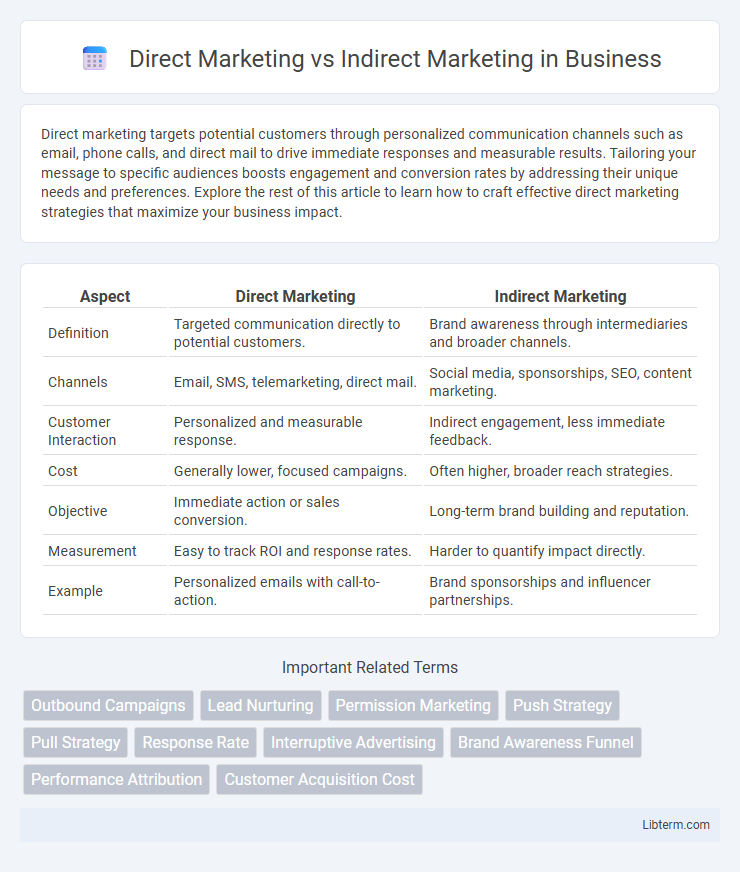Direct marketing targets potential customers through personalized communication channels such as email, phone calls, and direct mail to drive immediate responses and measurable results. Tailoring your message to specific audiences boosts engagement and conversion rates by addressing their unique needs and preferences. Explore the rest of this article to learn how to craft effective direct marketing strategies that maximize your business impact.
Table of Comparison
| Aspect | Direct Marketing | Indirect Marketing |
|---|---|---|
| Definition | Targeted communication directly to potential customers. | Brand awareness through intermediaries and broader channels. |
| Channels | Email, SMS, telemarketing, direct mail. | Social media, sponsorships, SEO, content marketing. |
| Customer Interaction | Personalized and measurable response. | Indirect engagement, less immediate feedback. |
| Cost | Generally lower, focused campaigns. | Often higher, broader reach strategies. |
| Objective | Immediate action or sales conversion. | Long-term brand building and reputation. |
| Measurement | Easy to track ROI and response rates. | Harder to quantify impact directly. |
| Example | Personalized emails with call-to-action. | Brand sponsorships and influencer partnerships. |
Understanding Direct Marketing: Definition and Key Features
Direct marketing involves communicating directly with targeted consumers through channels such as email, telemarketing, or direct mail to generate immediate responses and measurable results. Key features include personalized messaging, direct interaction, and the ability to track campaign effectiveness through metrics like conversion rates and customer acquisition costs. This strategy contrasts with indirect marketing, which builds brand awareness indirectly through broad media outlets like television, social media, or content marketing.
What is Indirect Marketing? Core Concepts Explained
Indirect marketing involves strategies that create brand awareness and customer engagement without direct communication or sales pitches. It leverages channels like social media content, influencer partnerships, and sponsorships to build trust and long-term relationships with potential customers. Core concepts include subtle promotion, brand storytelling, and creating value-driven experiences that encourage organic customer interest and loyalty.
Major Differences Between Direct and Indirect Marketing
Direct marketing involves personalized communication targeting specific customers through channels like emails, phone calls, and direct mail, enabling immediate response tracking and measurable ROI. Indirect marketing uses broader strategies such as brand awareness campaigns via social media, content marketing, and sponsorships aimed at building long-term customer relationships without direct sales solicitation. The major difference lies in direct marketing's focus on immediate action and measurable results, while indirect marketing emphasizes brand positioning and gradual engagement.
Benefits of Direct Marketing for Businesses
Direct marketing enables businesses to reach targeted audiences with personalized messages, resulting in higher response rates and improved customer engagement. This approach provides measurable results through tracking tools, allowing companies to evaluate campaign effectiveness and optimize strategies in real time. Cost efficiency is achieved by minimizing wasted exposure, as direct marketing targets specific consumers more precisely than indirect methods.
Advantages of Indirect Marketing Strategies
Indirect marketing strategies offer enhanced brand awareness by subtly engaging audiences through content marketing, social media, and influencer partnerships, fostering trust without overt selling. These methods build long-term customer relationships and increase organic reach by creating valuable, informative content that resonates with target markets. Indirect marketing also benefits from cost-effectiveness in scaling campaigns and the ability to appeal to broader demographics through diversified channels.
Common Channels Used in Direct Marketing
Direct marketing primarily utilizes channels such as email campaigns, telemarketing, direct mail, SMS marketing, and social media advertising to establish immediate and personalized communication with target audiences. These channels enable businesses to track responses and measure ROI effectively, delivering tailored messages directly to consumers. Common direct marketing methods emphasize direct interaction, prompting immediate feedback, unlike indirect marketing which relies on broader brand awareness through media like TV ads and sponsorships.
Popular Techniques in Indirect Marketing
Popular techniques in indirect marketing include content marketing, social media engagement, influencer partnerships, and search engine optimization (SEO). These strategies emphasize building brand awareness and customer relationships without direct sales pitches. Indirect marketing relies on creating valuable content and experiences to attract and retain a loyal audience over time.
Direct vs Indirect Marketing: Measuring ROI and Effectiveness
Direct marketing provides precise tracking of ROI through measurable actions such as clicks, conversions, and direct sales, enabling clear attribution of marketing spend to specific customer responses. Indirect marketing's ROI evaluation is more complex due to its focus on brand awareness and long-term engagement, often requiring sophisticated analytics like brand lift studies and sentiment analysis to gauge effectiveness. Businesses prioritize direct marketing for short-term measurable gains, while indirect marketing supports sustained brand growth and customer relationship development.
Choosing the Right Marketing Approach for Your Business
Choosing the right marketing approach depends on your business goals, target audience, and budget. Direct marketing delivers personalized messages through channels like email or SMS to generate immediate responses and measurable results, ideal for businesses seeking quick conversions. Indirect marketing builds brand awareness and customer loyalty over time via content marketing, social media, and public relations, suitable for businesses aiming for long-term engagement and broader market reach.
Future Trends in Direct and Indirect Marketing
Future trends in direct marketing emphasize hyper-personalization through AI-driven data analytics and real-time customer engagement, enabling businesses to deliver tailored offers and increase conversion rates effectively. Indirect marketing is evolving with enhanced influencer collaborations and immersive experiences via augmented reality, fostering deeper brand connections and expanding reach organically. Both strategies leverage digital transformation, but direct marketing focuses on measurable ROI, while indirect marketing prioritizes brand awareness and community building.
Direct Marketing Infographic

 libterm.com
libterm.com